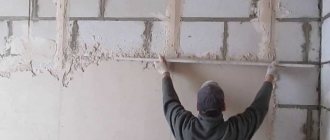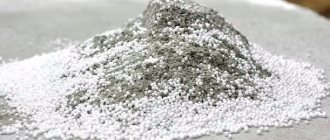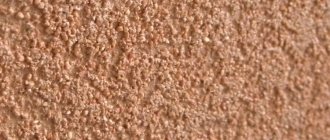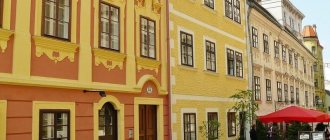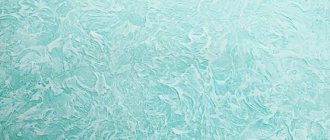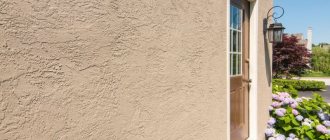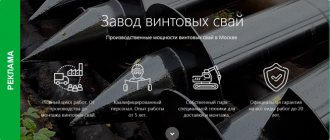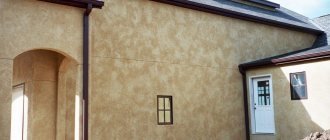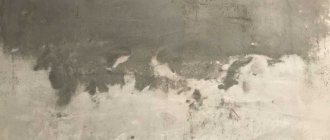What is thermal insulation plaster
When talking about plastering walls, the question that comes to mind is the labor intensity of the work and the need to attract specialists with experience and qualifications, but the classic application of sand-cement mixture to the walls does not solve the problem of wall insulation. With thermal insulation or “warm” plaster, there will be one less problem during construction.
When insulating, warm plaster is used for the facade and interior work. It is highly energy efficient, but remains an inexpensive construction raw material.
Material composition
For the manufacture of traditional plaster compositions, cement, sand, water, and, if necessary, mineral additives are used to add strength or frost resistance to the final product.
Thermal insulating plaster has the properties of both insulation and cement mixture.
This effect is achieved by applying a special recipe to the production of the material. The most common substances that are used to dilute the material to increase its energy-efficient properties of steel:
- expanded vermiculite;
- sawdust;
- granulated expanded clay crumbs;
- crushed pumice;
- granulated polystyrene foam.
Manufacturers and prices
The technology for producing the material appeared not so long ago, but there is already competition among manufacturers. Nowadays, the most famous heat-insulating plaster is of three brands: “Mishka” or “Varmix”, “Umka” and “Knauf”. Below is a description of each of them.
- Thermal insulation mixture "Umka". Popular material in recent years. It has gained fame as a product suitable for interior finishing work. The basis of “Umka” is granulated silicon balls. It has vapor barrier properties, does not absorb moisture, absorbs sound waves, and is an excellent thermal insulator. Silicon balls are odorless and harmless to human health. In addition to increased thermal insulation properties, due to granulated ceramic balls, the plaster composition acquires increased strength with a lighter specific gravity. Applying such a mixture to wall surfaces will not require additional treatment with primer compounds or installation of reinforcing mesh. In construction markets, “Umka” is sold at a price of 100 rubles per 1 kg.
- Warm plaster “Mishka” or “Varmix”. Some people confuse these two materials, but they have the same manufacturer, who has rebranded the brand. Like the previous insulation, “Mishka” in its raw form is a dry mixture, which is diluted in the required proportions with water before application to the surface. The finished composition has high adhesion properties to any surface, which eliminates the need to treat walls with primers. This is an excellent sound and vapor barrier material. “Mishka” has the positive properties of a competitor and is used as a heat-insulating plaster for exterior use. The price in the store per kilogram of “Mishka” starts from 120 rubles per kilogram.
- Thermal insulating composition "Knauf". Manufacturers took care of the versatility of the final product. Knauf can be applied to any type of surface. Even floor slabs are insulated and plastered with the mixture. Due to the fact that the plaster composition is applied both manually and using machine mechanisms, a person has the opportunity to save time when performing work.
DIY application technology
Warm plaster is used more often for exterior work. External wall plastering activities are carried out in warm weather. It is advisable that there is no wind. This way the result will be of better quality. If beacons are used, then after the coating has hardened they should be removed and the voids should be filled with warm plaster.
Preparatory work
The base requires standard preparation before plastering. To do this you need to eliminate:
- old coating in the form of plaster and paint;
- protruding reinforcement elements;
- available material for wall insulation;
- excess adhesive mortar between the blocks from which the building is constructed.
It is advisable to fill all the recesses first. Some manufacturers claim that priming is not required. Most experts disagree with this.
Therefore, it is recommended to carefully read the instructions for using warm plaster and still treat the surface with a strengthening or impregnating composition.
Necessary tool
To prepare the plaster you will need a container and a mixer. You can purchase a special attachment for a drill or hammer drill. To work with the solution you will need spatulas (facade and auxiliary) and a rule.
Devices and tools
When using beacons, plaster is applied by machine or manually. Then the mixture is leveled with a trapezoid-shaped cloth. The surplus is further used.
Reinforcement
When applying the solution in a single layer, no additional reinforcement is required. However, there is often a need for a coating in excess of 20 mm. In this case, use a mesh with cells up to 5x5 mm. It will not allow the coating to crack.
The reinforcement process looks like this:
- the first layer of plaster is applied;
- after 100-120 minutes, the plaster mesh is attached using a notched trowel;
- the next layer of solution is applied after 1.5-2 days.
Reinforcement
Each stage, with the exception of reinforcement, is carried out after the base or fresh coating has completely dried. Priming is taken into account in this case.
Calculation of the amount of material
Before covering the plaster, be sure to take into account the fact that the solution has a limited action time. As a rule, it is equal to 4 hours.
Layer thickness calculation
For sound insulation, a layer of warm plaster 5 mm thick is sufficient. For thermal insulation, 50 mm is considered optimal. For leveling, the layer is calculated depending on the differences that will need to be eliminated. If they exceed 5 cm, then it is recommended to first use analogues without heat-insulating fillers.
Mixture consumption
If the plaster layer is 20 mm, then you will need about 12 kg of dry mixture per 1 square meter. meter. With a two-layer coating, 2 times more material will be required.
Application
The rules for applying warm material are actually the same as for other analogues. The differences lie in the reinforcement and drying time of the coating. In particular, the latter is about 3 hours. Thermal insulating plaster gains maximum strength within a month.
Applying the mixture
To give smoothness, the hardened surface is moistened with water and treated with a grater. Possible deficiencies can be corrected within 2 hours.
Types of warm plaster
Technically, the material has the properties it needs due to the addition of insulating materials to the base. There are three types of mixtures based on composition.
- Vermiculite based plaster. This additive is produced by heat treatment of vermiculite rock. Expanded vermiculite has antiseptic properties, protecting wall coverings from the formation of harmful fungal growths. This lightweight mineral filler is added to ready-made dry mixtures, making it possible to use for facade work and interior decoration.
- A plaster mixture containing expanded polystyrene foam granules. The polystyrene foam content makes the plaster an excellent thermal insulator. In addition to this insulating material, the composition includes cement, lime, special additives and fillers. It is suitable for use as a warm plaster for external and internal construction work.
- Another type of this heat-insulating mixture is called “sawdust” , since in addition to cement, sawdust, clay, and paper are added to it. Due to the content of additional components, heat-insulating plaster for interior work is used for thermal insulation. Such warm plaster when performing external work on the outside of the wall is not resistant to constant exposure to moisture. However, it is also suitable for interior work. When insulating walls with this composition, keep in mind that during the period of hardening of the solution it is necessary to ensure constant ventilation of the room. “Sawdust” solution is applied to brick and wooden walls. Hardening time is about two weeks. If you do not ventilate the room, the surface of the finish will become covered with mold or mildew.
Technology of insulating walls from the inside with warm plaster
Warm plaster is applied to walls manually and by machine. In the first case, a spatula, trowel, trowel and other painting tools are used for work; in the second, a special mixing pump and a mortar gun are used.
Manual method of plastering walls
Before starting work, the contents of the entire package of warm plaster should be poured into a suitable container with a volume of 50-100 liters, water should be added in the amount specified by the manufacturer of the material, and then everything should be mixed using a construction mixer. It is necessary to know that the working capacity of the finished mixture is 2 hours. It is easy to check the required consistency of the mixture. To do this, you need to scoop up a little solution with a trowel and tilt the tool strongly. If the plaster does not fall off its surface, it means that it has acquired plasticity and is ready for use. Its consumption with a layer of 25 mm will be 10-14 kg/m2 of dry mixture, with a thickness of 50 mm - 18-25 kg/m2, respectively. The insulating mixture should be applied to the walls by hand in layers, the thickness of each layer should not exceed 20 mm to prevent the solution from sliding off the surface under the influence of its own weight. Each subsequent layer of plaster should be applied no earlier than 4 hours after laying the previous one. The drying time of the coating may increase at high humidity and low air temperatures, for example, in autumn. The working mixture must be applied to the primed wall surface from bottom to top, using a wide spatula, beacon profiles and a rule. The process of applying warm plaster without beacons and the quality of the resulting coating must be controlled using a 2 m long lath, a plumb line and a hydraulic level. The even plane of the plaster coating can be checked by applying a two-meter strip to it with its edge; as a rule, there should be no gaps between the tool and the wall. Small deviations of the finished coating from the horizontal or vertical are allowed, no more than 3 mm per 1 linear meter. Removal of lighthouse profiles from the coating should be done 4-6 hours after completion of the main work. The vacated cavities must be sealed with a plaster mixture and leveled using a trowel. It is recommended to check and accept the work for peeling, curvature and cracking of the coating no earlier than 3-4 weeks after the completion of plastering of the walls.
Mechanized method of plastering walls
To apply a warm plaster coating using a mechanized method, it is necessary to first prepare the mixing pump for operation, and then pour the dry mixture into the machine’s hopper. After this, in accordance with the desired consistency of the mixture, the dosage of water with the pump should be adjusted. It should be about 500 l/hour. Its exact value depends on the temperature in the house and the material of its walls. After preparing and turning on the pump, the mortar gun must be held at a distance of 30 cm and perpendicular to it when distributing the mixture over the surface of the wall. The thickness of the plaster layer during application can be easily adjusted by the speed of movement of the mortar gun. The smaller it is, the more powerful the layer and vice versa. The surface treatment must be carried out from the top corner downwards and then from left to right, while forming grips 0.7 m wide. The reciprocating movement of the gun should be such that the center of the spray of the mixture is located on the lower edge of the already applied plaster. The previous and subsequent grips should be overlapped on the left side by 10 cm. As in the previous case, the plastered surface must be leveled using the rule, and after the mixture has dried, remove the beacon profiles and fill the empty channels with the solution. After finishing spraying the plaster, the supply of the solution should be stopped by closing the air valve on the gun. The pump, hoses, gun and tools should be washed immediately with water. Important! The plaster mixture should not remain in a static state for more than 15 minutes while in a pump or hose.
Finishing layer device
As mentioned above, the final finishing requires insulation of the walls with warm plaster made on the basis of polystyrene foam granules. Before applying the final coating, the trowels and the container intended for preparing the working mixture in it must be cleaned of all foreign particles that could disturb the appearance of the coating during its processing. The finishing coat should be applied to obtain a uniform and presentable wall surface. Its thickness usually does not exceed 5 mm. After applying the final coating, it should be grouted using a trowel 300 mm long, made of metal or plastic. How to insulate walls with warm plaster - watch the video:
To summarize, we can conclude: warm plaster is a good alternative to other thermal insulation materials. It is especially effective for double-sided wall insulation. At the same time, the outside of the building additionally receives a beautiful finish, and from the inside it receives environmentally friendly and reliable insulation.
Cement heat-insulating plaster Knauf Grünband
Warm plaster Knauf Grünband deserves special attention. The Knauf product line itself is well known, but among them there are the most popular ones. Fractional components are no more than 1.5 mm in diameter. Application is carried out in two ways: manually and using electrical equipment.
This mixture is also used in addition to performing the main functionality. It helps solve other problems, such as:
- Application of waterproofing coating to the walls of facades, basements, sanitary rooms and other rooms with high humidity.
- Strengthening the surface of facades. The high characteristics of the Knauf Grünband mixture in the field of resistance to physical stress make it possible to protect walls from the effects of external conditions associated with the natural shrinkage processes of the soil under the building. As a result, cracks do not form on the surface.
- Decorative tasks. The structure makes it possible, through simple manipulations, to transform the plaster layer into a finishing decorative element for wall decoration. As a result, no additional painting work will be required, except for the final painting of the surface.
Knauf Grünband is sold in retail outlets in 25 kilogram containers. One bag, when applied to a wall 1.5 cm thick, is enough to treat a surface area of 1-1.4 square meters. m.
Top manufacturers
If we consider building materials from the point of view of manufacturers, the most famous brand is the German company Knauf. This brand has established itself among the first in the post-Soviet space.
The materials are of high quality. All tasks assigned to the material are carried out in accordance with the specified parameters. The main condition is compliance with the rules for using and preparing plaster.
Domestic analogues also cope with the main tasks, to one degree or another. For example:
- Houncliffe contains acrylic and glass. Can be applied to any porous substrate. It has low thermal conductivity, is vapor permeable, and does not accumulate moisture. It is environmentally friendly. The material is relatively new, so it is almost impossible to purchase a fake.
- Thermoum can be used to treat any substrate inside and outside the room. The plaster contains 99% mineral elements, which indicates its environmental friendliness and non-flammability. Pores in the coating occupy 55% of the volume. This allows moisture to not linger in the base. Hydrophobicity allows the product to be used as a moisture barrier for walls.
- Varmmix has high adhesion to any substrate without the use of primers. Unlike the previous option, it can be used for thermal insulation of the façade of a building.
Warm plaster Umka is suitable for indoor work. It is characterized by high strength and moisture resistance. It does an excellent job of insulating walls from noise and cold outside.
UMKA® UB 21 TM
This construction mixture contains special silicon (ceramic) balls with a porous structure as a filler. Despite the low price, it perfectly reduces the thermal conductivity of the main wall material, saves heat, and also provides reliable sound insulation. The product is suitable for all types of stone foundations and can be used indoors and outdoors. The characteristics of the plaster mixture are as follows:
- possible layer thickness - 10-100 mm;
- the amount of water per 1 kg of finished mass is 0.53-0.58 l;
- consumption per 1 sq. m with a layer thickness of 10 mm - 3.5-4 kg;
- solution lifetime - 60 minutes;
- thermal conductivity coefficient - 0.065.
“Umka” is so strong that it easily stays on the surface even without reinforcement, because the total weight of the dried layer is quite small. There are also other brand mixtures on sale - UMKA UB-212 (thin-layer, for hollow bricks and gas silicate) and UMKA UF-2 (decorative, for finishing with additional heat-insulating properties).
bear
Warm plaster Mishka is suitable for finishing walls made of any materials, both for external and internal work. The thermal conductivity declared by the manufacturer is 0.065 W/(m×°C) - the same as for Umka UB-21 products, which gives rise to some thoughts on this matter. 7 kg of dry mixture is mixed with approximately 3-3.3 liters of water, the solution consumption is approximately 3.5-4 kg/m2 at a 10 mm layer. The cost of a bag (7 kg) is approximately 650 rubles.
Knauf Grünband
The building mixture from Knauf is widely used for insulating facades, basements, and rooms with high humidity, as it additionally provides reliable waterproofing. It contains polystyrene foam granules, as well as special moisture-resistant additives that reduce the dispersion of the layer and prevent it from being saturated with wet vapors. The material has decorative properties and can serve as a finishing material.
Warm plaster is an excellent solution for reducing heat loss in housing. It is best to use it in combination with other insulation materials, because in this case the finished thermal insulation will be as reliable and durable as possible!
PALADIUM Palaplaster 207
As a filler, this sand-cement mortar contains foam glass - a durable, modern and reliable component in the form of small grains. It is porous, but does not absorb moisture, suitable for all types of finishing work. After applying the plaster, you don’t have to worry about fire safety: the plaster layer will be completely non-flammable. This building mixture will provide a high degree of noise and heat insulation for many years.
Super light warm soundproofing mixture PALADIUM PalaplasteR-207
De Luxe "TEPLOLUX"
Plaster of this brand is used for finishing concrete bases, as well as for insulating structures and buildings made of foam concrete. The adhesion of the product to these substrates will be the highest, which is due to the inclusion of small granules of foam concrete in its composition, which provides heat-insulating properties. The technical characteristics of the material are as follows:
- color - gray;
- filler fraction - up to 3 mm;
- consumption per 1 sq. m with a layer thickness of 10 mm - 4.5-5 kg;
- recommended layer thickness - 4 cm;
- adhesion strength - 0.4 MPa;
- compressive strength - 2.5 MPa;
- solution lifetime - 240 minutes;
- complete drying time of the coating - 14 days;
- thermal conductivity coefficient - 0.065;
- frost resistance - 25 cycles.
UNIS "Teplon"
Under the Teplon brand, 4 types of gypsum-based plaster are produced, 3 of which are used only in dry rooms, and one is moisture resistant, but is not positioned as heat-saving. The differences between Teplon gypsum plasters are in color (white or gray), as well as in the inclusion of special additives to increase the life of the solution (from 50 minutes for Teplon White and Teplon Gray to 90 minutes for Teplon MN). .
Work progress
Insulating plaster is applied to the wall surfaces using traditional technology. Before starting work, the surface is cleaned of dust and flaking elements. Some types of warm plasters do not require treatment with primer compounds, but for higher adhesion, applying a primer will not be superfluous.
The solution is mixed in construction containers with a volume of at least 50 liters.
It is written on the packaging how much liquid will need to be added to the mixture according to the technology. Some plaster compositions harden in a short time, so you should carefully study the instructions from the manufacturer to avoid discarding the material.
In order to save time, the work is entrusted to experienced teams who have already completed more than one project using this technology.
Plaster, suitable as insulation for the facade, is applied in the same way as that used indoors. When working with it, it is important to pay attention to the frost resistance properties of the material and its adhesion at sub-zero temperatures. In the process of plastering the facade with warm plaster with your own hands in winter, there is a risk that the solution will not adhere to the frozen surface of the wall. In the future, the layer will move away from the wall, and the material will have to be thrown away.
The material is applied to the walls in several layers. Each layer is not made thicker than 20 mm, and it can be applied no earlier than 4 hours after the previous one. To carry out the work, experienced specialists use construction spatulas of two sizes: wide and small. The quality of work is checked using two-meter rules with a level. This should be done 3 weeks after completion of work. The deviation of the plane from the level should usually not exceed 1-3 mm.
Calculation of the thickness of the layer of warm plaster
*
The composition is mainly used as an additional thermal insulation material, applied to the insulation. The use of plaster as the main thermal insulation is justified and rational only in regions with a mild climate. For use in other climatic regions, it is necessary to perform calculations depending on the conditions and characteristics of the wall material (aerated concrete, foam blocks, brick).
Most manufacturers recommend a layer thickness of 20-50 mm.
Important! To actually insulate a building with a wall thickness of 500 mm, it is necessary to apply a solution in a layer of 80-100 mm.
Preparatory stage
Applying plaster to insulate the facade will require more preparation before starting work than indoors. Work at height requires strict adherence to safety measures, the use of only certified equipment and building structures to ensure work safety. Before starting work, elements protruding from the body of the capital structure are removed from the surface of the external walls. After completion of general construction work, masons do not remove pieces of dressing reinforcement. They are cut to avoid future injury.
Work on the reinforcing layer
When the planning and preparation stage is over, the time comes when warm facade plaster is applied. In modern realities, this stage often begins with disappointment, as it turns out that the differences on the walls being treated are too great. Although solutions have great strength characteristics, sometimes this is not enough to avoid using reinforcing mesh as a load-bearing base.
The reinforcing layer is technologically designed to withstand loads from its own weight. Manufacturers provide data that their products do not require the provision of reinforcing mesh. In this matter, it is worth additionally monitoring the problem and obtaining expert advice, after which a final decision should be made as to whether the base should be reinforced under the plaster layer.
Advantages and disadvantages of warm plasters
Warm plaster is not ideal for interior construction work. Like any product, it has its pros and cons. Below is a description of the positive and negative features for the general group of thermal insulating plaster mixtures.
Positive traits:
- no deformation changes over time, wear resistance;
- high strength;
- absence of components harmful to health in raw materials;
- resistance to low temperatures;
- high adhesion properties;
- Possibility of application to any type of surface;
- in most cases does not require a reinforcing layer.
Mixture consumption
Plastering walls with the help of hired personnel may be accompanied by unjustified material costs. Control of the production of the mixture by builders is ensured by calculations based on data from manufacturers of thermal insulation material.
Consumption ranges from 10 to 18 kg per square meter. meter. The consumption of warm plaster for external work will reach up to 25 kg per square meter. meter, so a thicker layer must be applied to the external walls.
The numbers may differ from one manufacturer to another, but not to a significant extent. Consumption will become higher if the wall surface has too many unevennesses, as well as due to overspending by builders on defects. These points are worth paying attention to.
How to make warm plaster with your own hands
When it is not possible to purchase a ready-made mixture, you should try making it yourself. You can make warm plaster with your own hands in a simple way. It is important to note that for its manufacture it is not enough to simply add granules of insulating raw materials to the cement-sand mixture. A special plasticizer is used.
To make the composition you will need ordinary water, cement, thermal insulation filler (vermiculite) and a plasticizer. PVA glue is used as a plasticizer. The ingredients are mixed in the following proportion: to one part cement, four parts filler. 50 grams of PVA glue per bucket of cement is enough. Add water to the required consistency.
Plastering the surface of the walls with a composition made by yourself takes place in three stages:
- The plasticizer is diluted in water.
- Filler is added to the cement. The finished mixture is mixed until smooth.
- The dry composition is diluted with liquid, and the resulting solution is allowed to stand for 15 minutes.
After completing the preparatory work, the product is ready for use.
What kind of plaster is called warm
A typical plaster mixture - cement binder and sand, gives a coating with a density of about 1800 kg/mᶟ and a thermal conductivity of about 1.2 W/(m*C). Warm plaster (WP) consists of a cement binder and filler, which forms air pores in the monolith, reducing density and thermal conductivity. If cement is usually used as a binder, then there is a wide choice of fillers:
- Perlite is obsidian hydroxide, formed when lava hardened on the ground comes into contact with water. The nuclei resulting from hydration resemble rounded pearls - pearls, for which the breed got its name. It is characterized by high porosity (up to 40%) and the ability to absorb liquid in quantities exceeding its own weight (up to 400%). To prepare plaster, expanded perlite (perlite sand) is usually used - small granules of a white or light gray hue.
- Vermiculite is one of the minerals of the hydromica group, which is small layered flakes of brown-golden color. Like perlite, when heated it can swell, filling with air. In this form it is used in various industries, including construction, for the preparation of lightweight concrete and warm plaster mixtures.
- Expanded clay chips are produced from special varieties of low-melting clays by firing in melting furnaces rotating at a certain angle. This is a fine fraction of expanded clay with a granule size of up to 5 mm, sometimes called expanded clay sand. It is characterized by lightness, airiness, minimal thermal conductivity and the round shape of the granules.
- Sawdust is a waste product from the wood industry; small fractions are used for plasters, providing porosity to the composition, but not disturbing its structure and maintaining the homogeneity of the mass.
- EPS - expanded polystyrene granules are used not only for the manufacture of slab or bulk insulation, but also as a binder in ready-made or home-made plaster mixtures. If perlite and vermiculite are natural substances, EPP is the result of the chemical industry and is inferior to its natural “colleagues” in durability, biological and fire resistance. However, it copes with its assigned functions quite well - it makes the plaster porous and reduces its thermal conductivity.
In addition to the binder, filler and liquid, various modifiers are added to the plaster - to increase the elasticity of the mixture, to increase the service life, to prevent the formation of cracks during drying. Manufacturers of dry mixes add various branded water repellents and plasticizers. When preparing homemade plaster, microfiber, ready-made modifiers sold in construction stores, various detergents (liquid soap, dishwashing liquid) or PVA glue are introduced.
The coating obtained as a result of applying a warm plaster composition is not inferior to traditional cement-sand analogs in terms of adhesion to the base (adheses well to the wall) and strength.
Any finishing decorative coating can be applied to it. An article about interior materials will help you choose the right one. At the same time, it has low thermal conductivity - on average, 0.13 - 0.9 W/(m*C), and a density from 200 to 800 kg/mᶟ (depending on the filler). When using warm plaster, the load on the base is significantly reduced, and it is easier to work with the solution - per 1 m² of wall you will need to “master” less weight of the material at all stages.
Reviews
When using insulating plaster for exterior work, you kill several birds with one stone. This includes applying a leveling layer, installing thermal insulation, and even decorative finishing. If desired, this can be done in one step. You can’t do without mineral wool or polystyrene foam at a construction site, but you can use warm plaster and save time and money. And applying the composition is easier than carrying out thermal insulation work, followed by installation of a ventilated facade.
Manufacturers of warm plaster for interior work talk about the good properties of the mixtures in terms of sound insulation, however, in order to block the “airborne noise” the insulation material must have a fibrous structure and be blown, with a thickness of 5 cm or more, which in fact is not provided. Consequently, their properties are not so good in this direction.
Features of using warm plaster for interior work
Warm plaster is used to eliminate built sounds in residential areas. With its help, a so-called “airborne noise blocker” is created. To do this, you should give preference to warm plaster with a fibrous structure and airflow (the layer thickness should not exceed one centimeter. To eliminate “impact noise,” a mixture with high elasticity should be used.
There are also specialized warm compounds for insulating roofs, ceilings and floors. They are durable, impact-resistant and resistant to mechanical stress and environmental factors. This plaster can be applied to any type of surface - but preference is given to smooth, even coatings (aerated concrete or ceramic blocks). An excellent addition to warm plaster with increased elasticity is a vapor-permeable mixture (it is applied before plastering and serves as the basis for the heat-insulating layer).

